By the early ’70s, it was getting tough for anyone under 30 to partake of known muscle cars like the Pontiac GTO and Chevy Chevelle SS . . . not so much because they were expensive to buy, but because the insurance Mafia was making it increasingly impossible for the younger set to afford driving one as a result of extortionate premiums.
So the car companies did something clever: They began selling muscle on the down low . . . in nondescript packages such as the Pontiac GT-37 and (later) the Heavy Chevy. These cars had the same bodies as their infamous GTO and SS Chevelle stablemates – and in some cases, even offered the same drivetrains. But because they lacked the rep, their cost to keep was lower.
And it was really easy to upgrade their performance to full-boogie muscle car levels with no-one-need-know-about-it bolt-on parts. 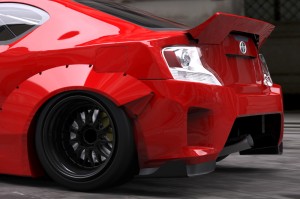
Fast forward 40 years to now. Scion – Toyota’s Millenial-focused small car division – is up to similarly laudable skullduggery.
There’s the known offender – the FR-S coupe – and its less-well-known tC stablemate. Both are sporty four-seater coupes; both are powered by punchy four-cylinder engines backed up with six-speed gearboxes (with a rev-matching downshift six-speed automatic now available in the tC).
But, price the cost to insure the FR-S vs. the tC – and you’ll quickly see the virtues of running under the radar.
WHAT IT IS
The tC is Scion’s other sports car.
It’s a different layout – FWD vs. rear-wheel-drive – and in-line four vs. flat four – but the experience is not completely dissimilar.
$19,210 is what Scion is asking for the base trim tC – vs. $24,900 for the least-expensive version of the FR-S. And then call your local Luca Brasi to find out what the difference will be to insure the FR-S vs. the tC . . . if you’re under 30 especially.
The tC also ought to be on your cross-shop list if you’re looking at the Hyundai Veloster or Kia Forte Koupe, among other sporty compact hatchbacks.
Taking a cue perhaps from the GTO-in-drag GT-37 of the early ’70s, the tC gets an FR-S-esque front clip as well as the throttle-blipping/rev-matching downshift six-speed automatic that’s now on the options roster. Inside, there’s a revised cockpit and center stack canted toward the driver, plus bolstered sport seats.
And for FR-S-esque performance, there’s a bevy of Toyota Racing Development upgrades available optionally and over the counter.
WHAT’S GOOD
Much stronger – and quicker – than standard-engined Hyundai Veloster and Kia Forte Koupe.
Quicker than the turbo-engined Veloster – and nearly as quick as the turbo Forte, too.
Lots of potential – that The Man doesn’t need to know about.
WHAT’S NOT SO GOOD
A bit pricier than Hyundai Veloster ($17,800 to start).
A bit less fuel efficient than base-engined Veloster or Forte Koupe.
More than a bit overweight.
The tC’s standard engine is Toyota’s 2.5 liter four, packing 179 hp and working through your choice of a six-speed manual or six-speed automatic transmission – the latter featuring rev-matching downshifts.
It’ll do the 0-60 run in 7.2 seconds.
Not bad for a bit over $19k to start.
Indeed, look at what you get for just under $25k to start in the FR-S:
2.0 liters, 200 hp and 0-60 in 6.5 seconds (7.9 with the optional automatic)
imagine what might happen with a little backyard tuning, some Toyota Racing Development over-the-counter parts. How hard do you suppose it would be to squeeze another 20 or so hp out of the tC’s 2.5 liter engine?
And who’s gonna know?
Or, let’s do some direct comparisons:
The tC is much more potent than either the Kia Forte Koupe or the Hyundai Veloster, two of its most obvious cross-shop competion.
The Kia comes standard with a smaller 1.8 liter four that makes 148 hp. The Veloster’s standard engine is even smaller and less powerful: 1.6 liters and 138 hp (132 hp if you select the automatic transmission).
The tC cleans both their clocks, easily: Zero to 60 in 7.2 seconds with the six-speed manual vs. an embarrassingly slow-motion 9.5 seconds for the manual-equipped 1.6 liter Veloster.
With the automatic, the poor Hyundai is another second slower.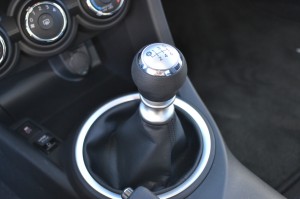
The 1.8 liter equipped Forte gives a better account of itself – zero to 60 in about 8.2 seconds – but it’s still no contest.
The tC could probably out-accelerate both the Forte and the Veloster with one of its four plug wires pulled off.
Now, the Veloster can be ordered with a turbocharged version of its knock-kneed 1.6 liter engine and – on paper – it sounds tough: 201 hp. But its actual performance is still not better than the Scion’s: Zero to 60 takes about 7.7 seconds.
The Forte also offers a turbo option – and so equipped, it’s quicker than the tC. But just barely. Put ’em side-by-side in a 0-60 drag and the Kia’s 7 seconds to 60 performance vs. the tC’s 7.2 second time translates to the Kia crossing the finish line about half a car length ahead of the Scion. That’s assuming equally skilled drivers. A tC piloted by a better, faster-reflexed driver could absolutely beat a Forte turbo with a mediocre driver behind the wheel. Two or three tenths of a second is within the proverbial margin of error. 
The tC’s gas mileage is surprisingly solid, too: 23 city, 31 highway – with either transmission. The turbo Veloster does slightly better – 24 city, 33 highway – when equipped with a manual transmission. Automatic-equipped models slip a little, to 24 city, 31 highway. And, keep in mindr: The turbo Veloster’s not as quick as the tC – and it costs more ($21,300 to start.)
The turbo Kia’s the thirstiest of the three, posting 22 city and 29 with the manual transmission and 22 city, 30 with the optional automatic.
Scion doesn’t offer an optional tC engine, but – relative to its competitors – the tC doesn’t need one. And its power/performance as it sits is already in the FR-S ballpark.
With a few choicely selected TRD add-ons and some fine-tuning, it’s a player – which I’ll get into now.
This car has a lot of potential – some of which was revealed during my weeklong test drive. Because the tC they sent me was a ringer, kinda sorta.
It was not “stock” – but the modifications that pepped it up can be spec’d out by anyone with a few extra bucks to toss the dealer’s way.
I refer to the slew of Toyota Racing Development (TRD) components that are available. Engine stuff, brake stuff, suspension stuff. You can order your car brand-new with these enhancements – or save up for them and buy them a la carte and over-the-counter. They can be installed as optional equipment by the factory – or later, by the dealer.
Or, by you.
Toyota is among the very few car companies that purveys factory-engineered and fully factory warranted upgrades this way. By “this way,” I mean – for cars that are budget-priced. Sure, there’s AMG for Benz and M for BMW. But what if you can’t afford a Benz or BMW? Let alone an AMG Benz or BMW M… ?
The Veloster and Forte are “take ’em or leave ’em.” You can certainly modify them for improved performance, but you’ll do so with potentially iffy aftermarket stuff – unwarranted and on your own.
My test car had the TRD wheel/tire package – 19s, with extremely aggressive short sidewall Toyo Proxes 35-series (and ZR speed rated) tires – street legal, just very aggressive – along with a TRD performance exhaust system that crackled and popped like my Kawasaki two-stroke triple and which had to have added at least 5 or so hp to the tC’s bottom line. Scion does not claim any power increase with the TRD exhaust bolted in place of the corked-up factory stock system, but there’s a reason why the first thing people with a need for speed usually do to their cars is hack off the factory muffler and pipes and replace them with larger-diameter (and freer-flowing) pipes and mufflers.
Seat of the pants-wise, this TRD-enhanced tC felt quicker than the TRD-free ones I’ve driven in the past. Regardless, the gnarly sound alone is well worth the $699 – and that’s installed and delivered with the car. You could order the parts over the counter, install them yourself – and save a bundle. Remember, these are factory engineered parts that will bolt right in. No “custom” work is necessary to make them fit.
The 19 inch TRD wheel (and tire) package is pricey – $2,199 – but mightily enhances the cornering grip (and steering quickness) of the tC.
In the right hands, on a road course, the TRD’d tC could probably keep up with an FR-S – and on the street, it’s a lot of fun to blitz around in. Few cars in this price range – which is just barely out of the economy car price range – are as fun to play with.
The tC’s brakes could stand the TRD treatment, however. The factory four-wheel discs are ok for everyday knocking around. But if you run the car track-day hard, the brakes are the first thing that will let you down. Luckily, there’s a TRD brake package – powder-coated high-performance calipers, drilled rotors – available over-the-counter.
The tC’s new front clip (and hood; that’s been updated, too) constitute an obvious effort to establish closer kinship with the FR-S – while the side view remains distinctively/historically tC blocky.
Gotta keep ’em separated… a little, at least.
Inside, you’ll also find an updated cockpit – with a revised center stack that’s canted (Pontiac-style, I might add) toward the driver. When I first saw it, I immediately thought about John de Lorean – the original GTO’s daddy – and also the guy responsible for the early ’70s Grand Prix SSJ, which had a similar-in-theme interior layout.
In automatic-equipped cars, you’ll find a shift gate that might have been directly borrowed from the original Lexus IS300 sport sedan; and all versions boast a new-design steering wheel that’s pleasingly beefy, with thumb spots and a flat-bottom. There is a pull-up (with your right hand) emergency brake – as opposed to a push down (with your foot) parking brake. The right people will understand the importance of the difference. The door are huge – and open really wide – which makes the car feel exceptionally roomy. Which it is, actually – especially relative to the FR-S – and also the cars it directly competes with.
The FR-S’s second row, for instance, is hopeless for humans: 29.9 inches of legroom and 35 inches of headroom. Forget about it. The tC, in contrast, has 34.6 inches of second row legroom and 1.6 inches more headroom (34.6 inches) which is enough to make it feasible – if not especially comfortable – for people to sit back there.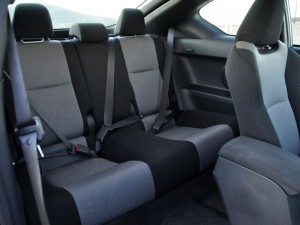
The extra room in the tC is a function of it being the larger car: 176.6 inches end to end vs. just 166.7 for the FR-S. The tC’s wheelbase is also much longer: 106.3 inches vs. 101.2 for the (ahem) Sciobaru.
So, in addition to being less expensive to buy – and much cheaper to insure – the tC also has some practicality going for it that the FR-S doesn’t.
Ditto with regard to the stylistically interesting but space-inefficient Hyundai Veloster. The back seats in this car are cosmetic affectations more than functional advantages. With just 31.7 inches of legroom and 35.3 inches of headroom to work with, well – there’s not a lot to work with.
It’s nice to have beck seats in a coupe … if you can actually use them.
The Kia Forte is the clear winner here – with (by far) the most generous backseat accommodations of the three: 35.9 inches of legroom and a very solid 37.3 inches of second row headroom.
Total cargo capacity is pretty much a draw. With 15.5 cubes (second row folded down) the Veloster is the nominal number one, but the next-best Kia comes in with 14.9 cubes while the tC slides into third with 14.7.
It’s not a difference that’s noticeable, though.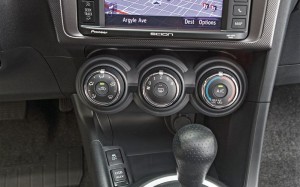
What is noticeable – and laudable – are the tC’s driving-focused controls. Of which there are few – and the few there are being large enough to operate by feel, without taking your eyes off the road. Like the three big rotary controls mounted on the center stack for air outlet direction, temperature control and fan speed.
That pull-up emergency brake is a nice touch, too.
I also liked the oversized rear quarter windows – which are both visually interesting and serve a worthy purpose: increasing your field of vision. All trims come with a two-section panorama sunroof, too: One large one for the front-seaters and another, smaller one for the back-seaters.
The base car also comes through with an eight-speaker Pioneer high-definition audio system and 6.1 inch touchscreen display and leather trim.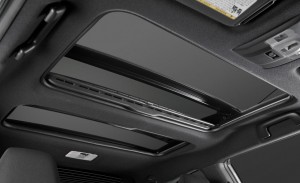
A “10 Series” package is available. It adds unique to this trim silver exterior paint with contrasting black powder-coated wheels, projector beam headlights, LED accent lighting and an illuminated “Scion” icon in the center console.
THE REST
This car practically begs to be worked on. Improved. TRD has done the heavy lifting – the engineering – for you. There’s no guesswork, no grafting. The parts were made for this car, designed to work – and to fit.
And it looks to be easy to work on.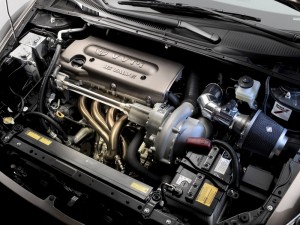
The starter motor for the engine, for example, is readily accessible. This will be helpful at some point down the road. And bolting on a set of headers to go with the TRD exhaust plumbing should be pretty straightforward, too. One of the great advantages of the transverse engine/FWD layout is that one side of the engine – the important (exhaust manifold) side – is easy to get at.
My main beef with this car is that it’s beefy: 3,082 lbs. empty. The slow-motion Veloster weighs almost 500 pounds less (2,584 lbs.) Imagine what the tC could do, performance-wise, if it weighed what the Veloster weighs.
Even without any TRD upgrades. 
Even so, the fact that it manages to bitch-slap its rivals despite all that beef is pretty damned impressive.
THE BOTTOM LINE
With a turbo kit, the extra 500 pounds would not matter – and the tC would be truly fast and furious.
Best of all, The Man need never know about it.
Throw it in the Woods?
We depend on you to keep the wheels turning. If you value alternatives to the MSM, please support independent media. Our donate button is here.
For those not Pay Pal-inclined, you can mail us at the following:
EPautos
721 Hummingbird Lane SE
Copper Hill, VA 24079




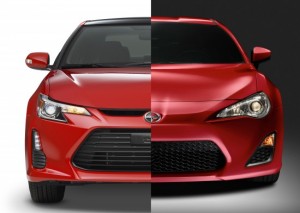

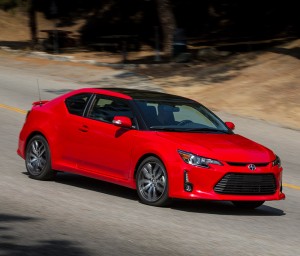
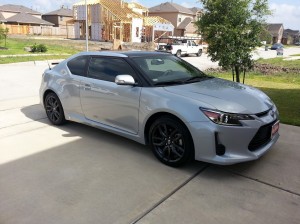







How was the interior quality of this Tc Eric?
This is a much more favorable review than I expected. A pleasant surprise with good relevant/competitive information.
However.. Re: the weight issue. All trims come with 30 extra pounds of glass, metal and electric motors mounted as high as possible in the car. Not exactly helping the weight or the CoG by doing that. I had to seek out my sunroof-less M Coupe. It’s a shame that’s not an option for these for somebody that looking for the budget performance coupe and never opens those things, like me. (I guess sunroofs/moonroofs are to me what ABS and DCTs are to you… We had to get our van from 60 miles away because I wasn’t paying $900 or so for a glass window in the roof of a minivan.)
The TRD brake upgrade seems reasonable for what you get. Aftermarket wheels and tires aren’t going to void any warranties. I’d stick with 18″s and get some RPF1s or something since they’re cheaper, and most likely considerably lighter and stronger. Those OEM 19″s gotta have some mass.
“The wheel/tire package really wakes it up, by the way. I think even you’d be impressed!”
Touche Eric! Perhaps I would be impressed. But this would make the tC more an affordable New Millennium GTi rather than a NM GTO. 😉
My 2 cents.
If I were in the market for a car, I would shell out the extra bucks for a 2+2 sports car/pony car over a “sporty sedan.”
I can’t see passing up a Mustang at 24K, a Miata at 25K, or a Scion/BRZ at 26K for a “sporty sedan” at 20K. To me 5K or so in savings would not be worth the sacrifice in both visual appeal and driving experience.
The sports car/pony car, with its lower to the ground seating position makes the car look sexier from the outside, and also provides a more fulfilling driving experience from the inside.
Sure, a “sporty sedan” could even turn out performance numbers that are even better than a true sports car or pony car. But the gut level experience just isn’t the same. That difference in subjective feel is worth paying for in my book.
Hi Bevin,
I’ve come to appreciate sport sedans – if one must choose one car and cannot own a second car. In which case, make mine a sport wagon!
Dear Eric,
“sport wagon”
Now you’re talking!
If I had to “settle,” I would rather settle for a sport wagon than a “sporty sedan.”
The latter is just too undistinguished. Not enough character.
A sports wagon on the other hand, has a nicer looking profile as well as more interior volume than a bland “sporty sedan.”
http://www.bmwblog.com/wp-content/uploads/DRV_7227.jpg
http://egmcartech.wpengine.com/wp-content/uploads/2012/05/2013bmw3sportwagon-08-627×470.jpg
Bevin, me too. I’m all for sportswagons. I’m an El Camino guy, like James Garner who just passed away, a guy always looking for a souped up anything. Who said that 14 L Cat won’t get another 50KW, just add another turbo inline and turn the injector pump up a bit. I was just scolded online by a friend who compared me to his oldest son, never being satisfied with anything stock, and we were discussing firearms. I like the looks of wagons over sedans almost every time. TRD really appeals to me on a basic level of “here, knock yourself out”…..and I will. My Elco has WS 6 TA suspension parts under it as well as unique factory wheels capable of very large tires.
One thing I never understood, although I always thought it was collusion between the auto makers and the insurance industry who sought to profit from what was perceived as excess. I’m referring to the Chevelle SS 396 of which there was never such a thing produced. The limit back then was 400 CI for the breakover point of insurance so the 396 came in just under that point. Problem was, GM never made a 396 CI engine, they were all 402 CI BB’s. Still, it did my heart good to “screw the man” so to speak.
Dear 8sm,
I used to love the El Camino — the Ranchero too. I loved the looks, and the cargo capacity.
To be frank though, they were gawdawful in one respect, weight distribution when empty. Especially with a bigger engine.
I never owned one, but people who did said it was way too easy to break the rear wheels loose and have them spin uselessly, getting absolutely no traction!
LOL.
Hi Bevin,
That was true of just about any American muscle car from back in the day!
Big engine up front, not much weight on the rear end, and skinny (15×7 tires) all around…
“GM never made a 396 CI engine, they were all 402 CI BB’s.”
I did Not know that.
Anyway, I can sortof appreciate you guy’s appreciation for sport wagons and El Camino’s. I kind of consider you guys to all be a bit like Jim Rockford.
That is: kewl.
How-freaking-ever; pickup trucks Rock. [Specifically 4×4]…No matter how light the tail end is… [just add a few bags of salt].
But, I like your style and a dash of practicality none-the-less.
This was posted before I made my comment: “I never owned one, but people who did said it was way too easy to break the rear wheels loose and have them spin uselessly, getting absolutely no traction! ”
Like a ’65 Mustang?
Did a few bags of salt in the back make a difference in either one?
…WHoa, look at us talking about traction, like the golden leaves I’ve seen falling from the trees lately, this is just one more indication this will be an early Winter, and a hard one like last year.
Mock me, and make wrong. …Pahlease.
My Trans-Am is like that!
At anything less than about 20 MPH, if I give it full throttle, the back end will fishtail all over the road because 15×7 wheels and 245-60 tires cannot deal with the 500 ft.-lbs. of torque made by a warmed-over 455 (7.4 liters, for Clover) Pontiac V-8!
Far from “efficient.” Most assuredly not “safe.”
But, it’s fun!
Dear Eric,
A coworker who had a T/A similar to your first one let me drive it around the block one time. This was the mid 70s.
I had never had so much power and torque at my disposal in my life. Moving away from the light, I totally unintentionally did a burn out!
I was used to the 40 HP of a VW Bug. I released the clutch at roughly the same rate as I did on my Bug, and boy was I surprised.
LOL!
My 91′ Firebird was about the same.
It didn’t go Nowhere in 1/4″ of snow. A tidly amount of snow would strand it.
But it sure was a pure joy on dry pav4ement.
I almost miss it. …It was almost a motorcycle.
https://www.youtube.com/watch?v=tk52nGxF-jc
“I had never had so much power and torque at my disposal in my life. Moving away from the light, I totally unintentionally did a burn out! ”
Way cool.
Dear helot,
That experience made me realize how spoiled you guys who have owned pony cars and muscle cars must be.
Highway passing in a 400 HP T/A has got to be a cinch compared to passing in a 40 HP Bug.
The old stuff is like nothing else!
The new stuff is as or more powerful than the most powerful of the ’60s and ’70s stuff… but, the power delivery is modulated by tires, suspension systems and brakes that are as capable as the engines are powerful.
In a classic muscle car, you’ve got this monster engine… feeding power to easily overwhelmed tires, with no intervening traction or stability control. The brakes – marginal at best – required forethought and plenty of stopping distance (few things in life compare, pucker-wise, with the feeling of the brakes just going away as you try to decelerate from triple digit speeds). The suspensions were – typically – pretty much what you’d find underneath a truck of the same vintage. My TA, for example: A solid axle suspended by leaf springs, with a pair of shocks. Up front, stamped steel control arms, coil springs and pretty basic shocks.
But, this crudeness was part of their appeal. They were – are – animals.
Not for Clovers!
Actually, El Caminos had better weight distribution that Chevelles which had pretty dang good weight distribution compared to everything else out there. I knew several people who used Elco’s for drag cars and they’d hook up and haul. My old ’77SS would jump sideways going into 2nd but it didn’t quite break loose and that was an Eddy Browder engine, far from stock. With the WS 6 parts it handled pretty well too for a 4300 lb. auto. With the trailer towing package it would even stop well. I do love that car. The SS’s had the Monte Carlo interior with the swivel buckets that were comfy in their own right but spinning around and stepping out was nice as was turning around, sitting down and spinning back to the front. Bevin, the Ranchero, when it was based on the big car platform had so much weight in the front they wouldn’t turn for crap but were comfortable and looked cool. The first Ranchero I drove was based on the Falcon and they were just pitiful although somebody was always sticking a V-8 in them and overpowering everything else about them.
Dear 8sm,
Thanks for that info on El Caminos and Rancheros.
I didn’t know that!
It’s amazing how much good stuff one can pick up from the truly savvy people here!
Unless one happens to be clover of course. There are none so blind as those who will not see.
Well I’d choose even a stock Scion tC over the Kia or Hyundai.
You’re right about the advantage of Toyota warrantied TRD parts available from the manufacturer. Since they can be installed on a new car by the dealer, and usually financed into the original purchase price, you might even argue that they are not “aftermarket” additions. That would be at least a half truth.
Still, it’s neither accurate or fair to compare one car with “after manufacture” additions against two other models that are truly stock, and denied a similar
advantage.
And sorry, but installing racy wheels and a fart can muffler on a Scion tC does NOT make it a New Millennium “Muscle Car.” 😉
Hi Mike,
The thing that most appeals to me about the TRD stuff is that you can do the upgrades as and when money permits. Buy the car “stock” this year, then next year – after you’ve had a chance to save up – buy the brake kit, or the muffler. Then maybe the tires – or the springs.
It’s cool that Toyota supports – and encourages – this sort of thing.
The wheel/tire package really wakes it up, by the way. I think even you’d be impressed!
That engine pic — is that a geared supercharger?
Hi Chip,
I’m not sure; I’ll see whether I can find some details….